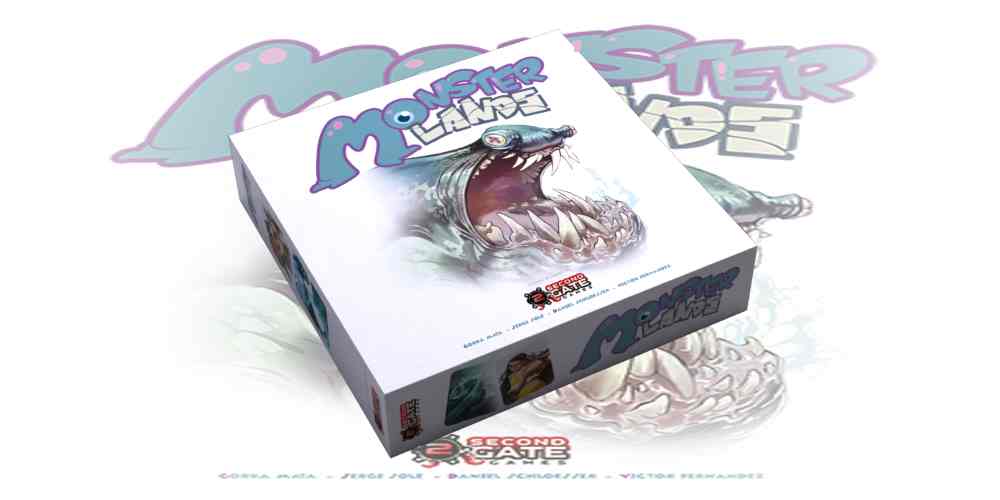 The King is dead. His lands overrun. The Queen has put out a call to arms. Brave warriors are needed to win back the lands outside the Citadel. For glory and reputation, these mercenaries will fight, but only one clan will claim the right to rule the lands of Modhelm!
The King is dead. His lands overrun. The Queen has put out a call to arms. Brave warriors are needed to win back the lands outside the Citadel. For glory and reputation, these mercenaries will fight, but only one clan will claim the right to rule the lands of Modhelm!
What is Monster Lands?
Monster Lands is a strategic dice-based worker placement game for 1-4 players. It’s moderately complicated with two distinct tasks for players to wrestle with: 1) Inside the Citadel, players muster their forces. 2) Outside, they must deploy their armies of mercenaries to complete missions, slay monsters, and win back lands for the Queen.
Games last 6 turns or until one player has scored thirty Glory points. This will likely take upwards of two hours and use a metric tonne of dice.
The game is looking for funds on Kickstarter now. €54 ($64 approx) will bring you the basic game, whilst €84 ($99) will bring you a very funky monster edition, with some very nice wooden components, and the cutest custom dice.
New to Kickstarter? Check out our crowdfunding primer, and visit our Kickstarter curated page for more projects we love.
The production values that went into the prototype copy I was sent were phenomenal. Far above any prototype I’ve seen before. There was nothing to suggest it wasn’t a production copy. The theme and artwork style of the game is very much its own. The layout and board components have been very well thought out.
Speaking of which…
What’s in the Box?
- 1 Gameboard.
- 4 Clan Progress Tracks.
- 86 Cards. Broken into 5 types:
- 8 Initial Clan Member cards (2 per player.)
- 32 Mercenary Cards (The fighters that will do battle for you.)
- 16 Monster Cards (The things they will fight.)
- 18 Equipment cards (The items they will fight them with.)
- 12 Land Cards (Oh, the places you’ll go!)
- 255 Cardboard Tokens:
- 4 Reputation Markers (one for each player.)
- 4 Glory Markers (one for each player.)
- 32 Mercenary Assignment Tokens (used when sending your mercenaries outside of the castle.)
- 64 Trap Tokens (used to help capture and kill monsters.)
- 20 Defense Tokens (used to stop monsters killing your mercenaries.)
- 16 Potion Tokens (to heal your mercenaries.)
- 16 Venom Tokens (more help to kill monsters.)
- 16 Loot tokens (because who doesn’t like loot?)
- 1 First player token.
- 1 Round Marker (that is both round in shape, and tells you which round you’re on.)
- 6 Double-sided Land Path headers (more on those later.)
- 1 Double-sided round modifier token.
- 7 Panic Tokens.
- 12 Mission Tiles.
- 80 Six sided dice:
- 32 Red Dice (Strength Dice.)
- 22 Purple Dice (Magic Dice.)
- 18 Yellow Dice (Persuasion Dice.)
- 8 Black Dice. (Monster Dice.)
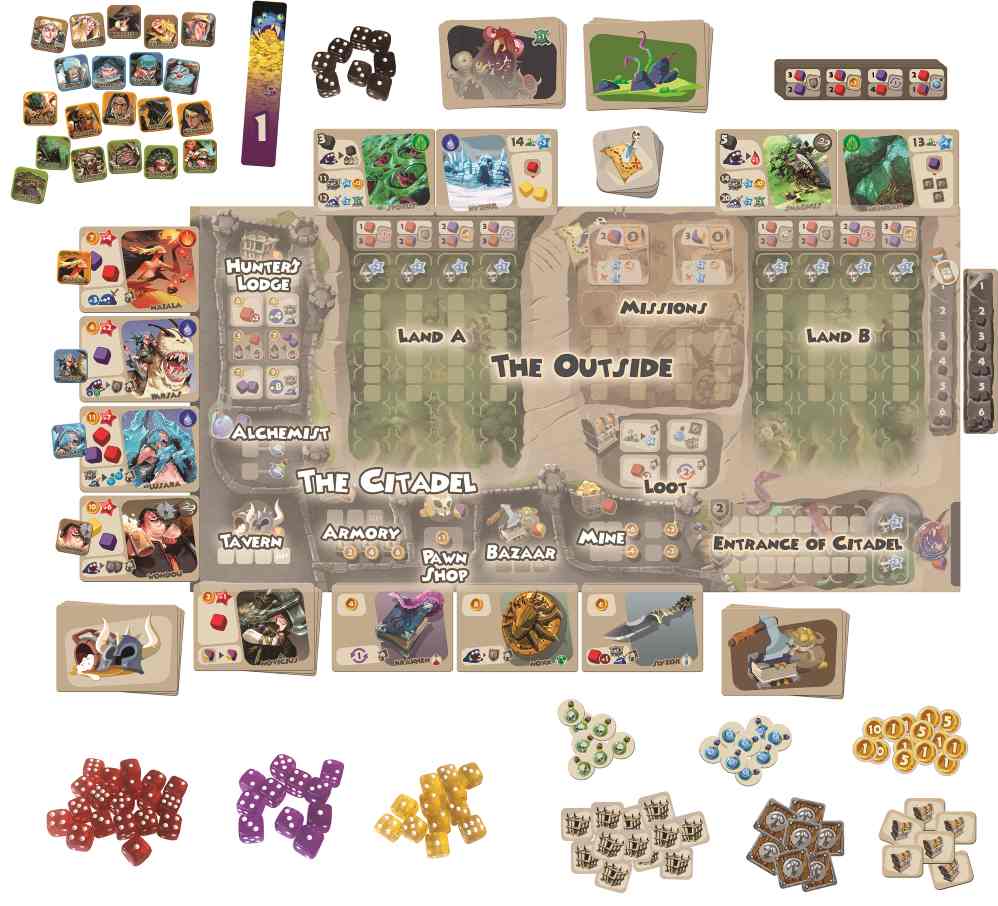
How do you play Monster Lands?
There is a fair amount to explain in the rules of Monster Lands; what follows is a comprehensive overview. If you want the full details, the rulebook can be found here. For a full playthrough, you can watch the video below.
Like many games, when you read the Monster Lands rulebook, it feels like you’ll never understand how to play. At first glance, there are a lot of aspects to the game, some of which you can’t really understand how they fit into the game until you’re playing it. In the end, we just got stuck in and started playing. We made a few mistakes, but the game is intuitive and it doesn’t take long to understand how to play.
Basic Concepts:
- The Monster Land board has two main areas. Inside the Citadel and Outside the Citadel. These are delineated by a dotted line, a line that doubles as the Citadel’s crenellations. This detail gives a flavor of the thought that has gone into the game’s component design.
- Inside the Citadel is where you hire and equip mercenaries. Outside is where your mercenaries fight and conquer to bring you glory and reputation.
- The game is won by gaining the most glory, reputation, and conquering new lands.
- These can only be done by mercenaries, which you hire inside the Citadel.
- All mercenaries give you dice. These represent actions you can use to do things, whether it be hiring, equipping, or venturing outside.
- There are three colors of dice. Red – for strength, Purple for Magic, and Yellow for persuasion. When you can use which type of dice is outlined on the board.

How do I set up the board?
Setting up the board for the first time can be a little bewildering. As you can see from the components list, there is a lot of cardboard.
For the initial set up each player receives:
- A Player Board.
- Two heroes of a corresponding element. (The game has four elements Earth, Wind, Fire, and Water. There are 8 starting heroes, 2 for each element.)
- Combined, the starting heroes give each player a die of each color. Additionally, the player board gives one red die. This gives each player a starting pool of 2 Red, 1, Yellow, and 1 Purple die.
- At the start of the game all players start with 1 Reputation and 5 Glory.
- The players each get 7 Gold and a Trap (more on those later).
The Citadel section of the board has 6 distinct sections:
- The Hunter’s Lodge: Players can buy their mercenaries’ traps here. Traps are used when vanquishing monsters outside the castle.
- The Alchemist: Where you buy health or venom potions.
- The Tavern: This is where mercenaries sit around waiting to be hired.
- The Armory: Where you buy shields to protect your mercenaries.
- Pawn Shop: You can sell dice here, but the return is awful.
- The Bazaar: Here you can buy artifacts to aid your mercenaries on their quests. Sadly, no trifles.
- Mine: Can be mined for gold.
Each zone is set up as follows:
- The Hunter’s Lodge gets 6 traps face up.
- The Tavern has four Mercenary cards placed next to it. Note: There must be at least one mercenary per player with a reputation of 4 or less when the board is set up. Another Note: A pile of “Novicius” cards is also placed in the Tavern.
- The Bazaar has 3 Equipment cards placed next to it.
- The other zones are left empty.
The “Outside” sections of the board has 5 distinct sections.
- Land A. This has four tracks on it.
- Land B. Also with four tracks (Only used in 3-4 player games.)
- Missions (2 tracks. Only 1 used in a 1-2 player game.)
- Loot.
- The Citadel Entrance.
Each outside zone is set up as follows.
- Land tracks are given one monster card and one land card.
- Each land track is also given a land track header.
- Mission tracks get one mission card each.
- Four loot cards are placed face up on the board.
- The Citadel Entrance is left clear.
Finally:
- A pool of shields is kept near the board.
- A pool of potions (healing and venom) is kept near the board.
- The remaining traps are kept near the board.
- Separate piles of Mercenary, Equipment, Monster, and Land cards are kept near the relevant board sections.
The player who wants to win the most is given the first player marker.
What happens in a turn of Monster Lands?
Game turns are defined like this.
- Dice Pool Preparation Phase.
- Deployment Phase.
- Adventure Phase (The resolution of stuff outside the Citadel.)
- Clean up Phase.
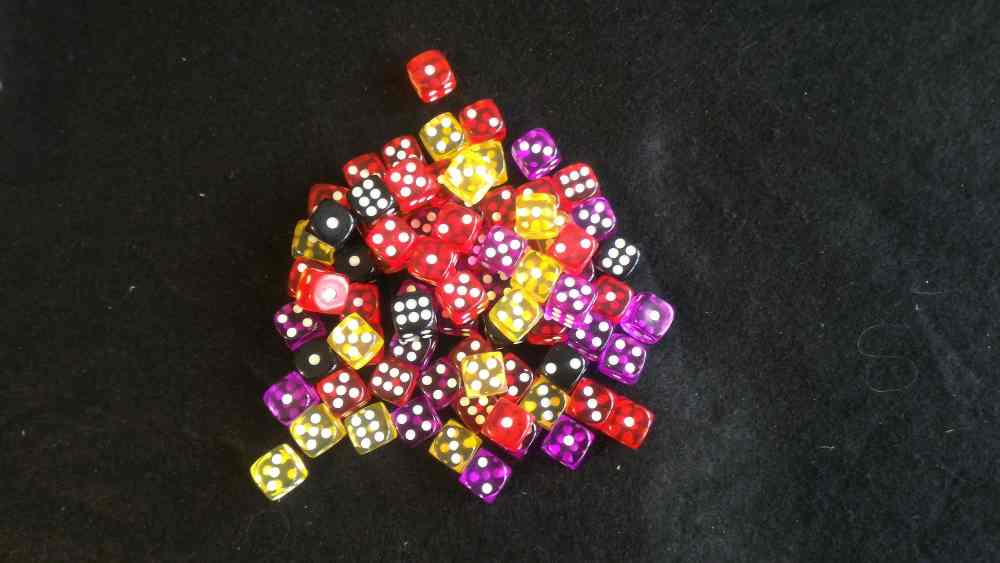
The Dice Pool Preparation Phase involves ensuring you have all the dice afforded to you by mercenaries (as given on their cards.) Initially, this will be four dice. Players’ Persuasion dice are rolled at this time.
Starting with the first player, players take it in turns to place one of their dice in an open worker slot on the board. Initially, these will be inside the Citadel as you attempt to build up the strength of your clan. Once all the dice have been placed (whether inside or outside the Citadel) the deployment phase finishes and, if applicable, the Adventure Phase begins.
Different areas of the board require different types of dice. The Mine, for example, allows only red dice. And some slots are more beneficial than others (the initial Mine slot garners 6 gold and subsequent ones 4 and 2.)
There are also limited numbers of slots, so careful balancing and prioritizing are required.
This balancing and prioritizing is given further tactical importance thanks to the yellow Persuasion Dice mechanic.
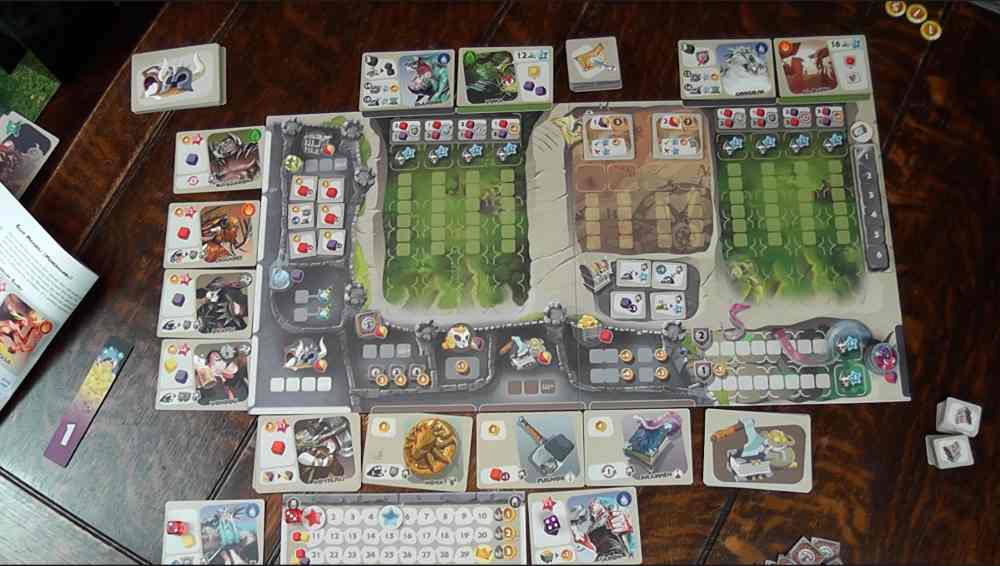
How do Persuasion Dice work?
At the start of the turn, you roll any Persuasion dice your warband generates. At the start of the game this is 1. The value of the dice rolls are important. You must keep each die at the value you rolled.
Most things inside the Citadel cost money, whether it be a new mercenary, artifact, trap, or shield. If you use a red die you pay the base cost of the thing you want to buy. Using a Persuasion die allows you to reduce the price – you’re persuading the seller to bring the price down. You can reduce the price by the number given on the Persuasion dice.
For example: If you want to recruit a new mercenary, you have to pay the cost given on the relevant card. If you used a red die, that’s the price you pay. If you used a yellow Persuasion die, you can subtract the value rolled at the start of the turn. If the mercenary normally costs 5 gold and you rolled a three on your Persuasion die, you only pay 2 gold.
But there’s more…
If you are playing your Persuasion die in a slot directly after another Persuasion die, if the value is LESS than the previous value, you can combine the two. If you were thrilled to roll a 6 and picked up a trap for just 1 gold. Imagine how pleased your opponent will be when they put their yellow die worth 5 next to yours and can now pick up something worth 12 for only 1 gold (12 – (6 + 5)). If the following player had a Persuasion die value 4, they could claim a discount of 15 (6+5+4) gold!
Note: The minimum cost of a transaction is 1, no matter what your Persuasion score. Another Note: You don’t only have to buy one item at a time. Gold can be spent on more than one item from the same section, so in the example above, your 1 gold could buy you three traps worth, 2, 4 and 5 gold. Quite the bargain.
This is a great mechanic as it means even rolling a 6 on your Persuasion die gives you pause for thought. It’s great for you, but if you employ that dice straight away, somebody else is likely to benefit even more than you do.
Note: If you play your Persuasion die and it has a HIGHER number than the previous one, all previous dice are ignored.

How do I recruit new mercenaries?
As outlined above, new members of your clan are recruited by visiting the Tavern and paying the cost on the card. If you do this the mercenary immediately joins you. You take the card and place it next to your player board. The Tavern is immediately replenished.
Recruiting a new mercenary does two new things.
- You immediately get new dice to use, given by the color(s) on the card.
- All new mercenaries bring you extra reputation (marked by the value with a red star on their card.) Your reputation score (marked by the red counter on your player board) immediately goes up by that amount.
VERY IMPORTANT NOTE: You can only recruit mercenaries of Reputation LESS than the difference between your clan’s Glory and Reputation. At the start of the game, your glory is 5 and your reputation 1. Which means you can only recruit mercenaries of reputation 4 or less (or two of 2.)
In practical terms, this means that very quickly you’re going to need more Glory, and that means venturing OUTSIDE!
Anything else I need to know about mercenaries?
As well as giving you a die (or sometimes several), all mercenaries have an additional power up that can be used once per turn. Some can be used at any point in the turn, but many are specific to a particular phase, most usually the Adventure Phase.
There are also 8 Novicius cards available. These are cut-price novice mercenaries that cost two gold and only have one reputation. They CANNOT be used outside the Citadel, but they do give you an additional red die. They also have the power to convert one die of any color into another die of any other color (once per turn, per Novicius). Do not underestimate the power of this ability.
All mercenaries (except Novicius) have an elemental affinity. This can be useful when totaling victory points. You score additional points for the numbers of mercenaries or lands you own that have the same affinity. The more synergy you have, the more you score.
All mercenaries have an upkeep that must be paid during the end phase. This starts at 1 Gold per mercenary after your initial two (Novicius included). Once your glory goes above 10, upkeep costs even more (though you do get an extra die), and once it goes over 20, upkeep goes up to three gold per mercenary.
Failure to pay your mercenaries means the one with the highest reputation (and therefore usually the best) immediately leaves. This can be disastrous, so keep on eye on your Glory track and gold reserves to make sure you don’t accidentally run out.

“Glory, Glory, Monster Lands” – or How do I win this game?
The only way to win Monster Lands is to head outside. This opens up a whole new tranch of rules. It’s important to make sure you are well enough equipped to take on the trials found outside the safety of the Citadel. Failure to do so will likely result in mercenary death, and frankly, that’s just a waste of your hard-earned gold.
Instead of using some of your dice pool for obtaining stuff inside the city, you can, at any time when it’s your turn to place a die, venture outside. Doing so does put you at some risk.
You don’t move your mercenary card. Instead, each mercenary has a corresponding “Mercenary Assignment Token.” This is placed on the section of the board you wish to explore.
Before venturing outside the Citadel, you need to give your mercenary all the equipment you think they’ll need. Once the assignment token is on an outside track you cannot add anything else to that mercenary’s equipment stockpile.
What are tracks?
Each of the areas outside of the Citadel has a number of “tracks.” These are where you put the dice and equipment that you want to use to overcome the obstacle you are tackling.
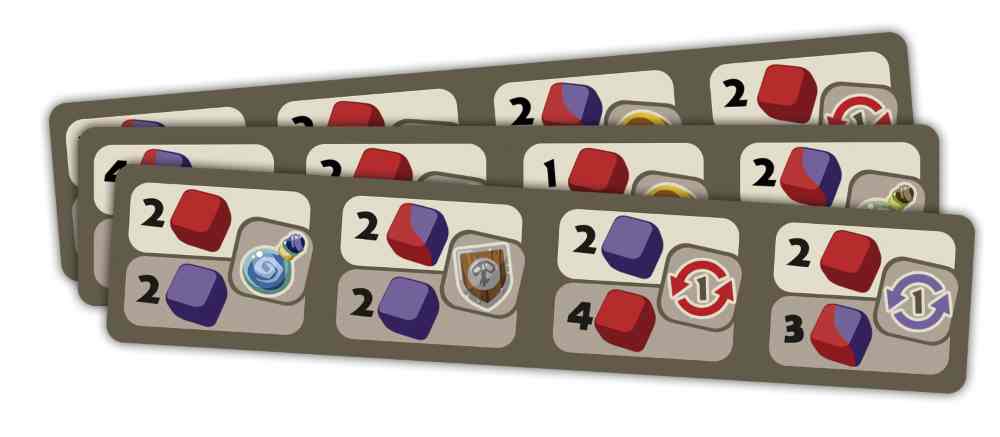
There are a number of important things to consider when looking at tracks.
- Land tracks have special moveable header tiles on them. These add variation to the game. They tell you what requirements you must fulfill to use the particular track that they sit over (e.g. 2 dice that are either red or purple). They also tell you what bonus dice you are allowed to deploy (e.g. 2 red dice). Deploying the bonus dice usually gives you an extra boon.
- The rules of the header tile must be adhered to. This will make some tracks easier than others. Generally the more dice you are allowed to deploy, the greater the chance of success.
- You can put your mercenary at the head of any track, but they are always resolved from left to right.
- This means that whilst track 3 might be easier, if you put your dice on track three and somebody else goes for track 1, they will get first crack at overcoming the monster and you might lose out.
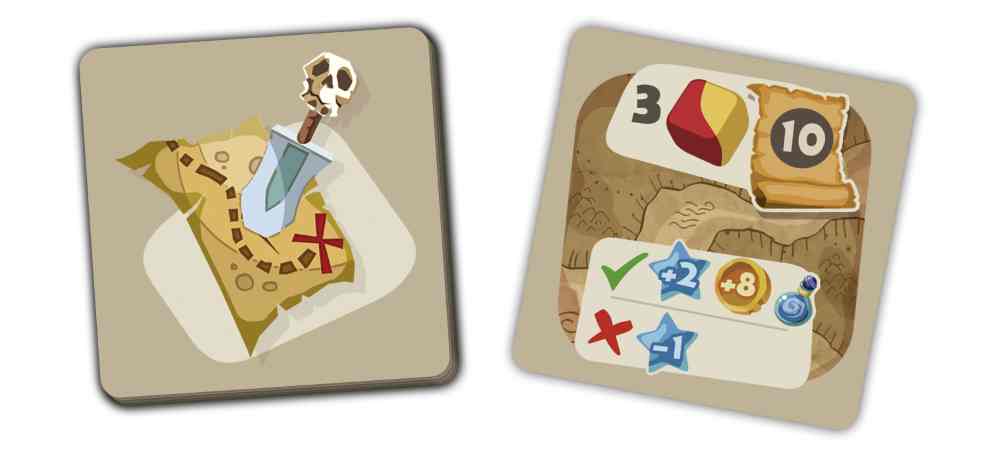
What is a mission?
The simplest way to gain some glory. They are easier to overcome than monsters or lands.
Mission tiles have very simple requirements to overcome them. These will often be your first attempts at gaining glory. In a four-player game, there are two separate missions and players can choose either one to attempt. Each mission has two tracks. As with lands, you can choose which one to use, the left or the right.
Again, the left track is always resolved first. Since missions have no path header, both tracks are the same difficulty. Therefore, it makes sense to choose the left one first. Other players may subsequently populate the 2nd track in the hope that the first player fails.
The mission tiles have a simple obstacle to overcome. Usually rolling 1, 2, or 3 dice and scoring over a certain number. Success will give some glory and perhaps another boon. Failure will result in a loss of glory. Employing mercenaries that have a reroll capability is a useful thing to do on missions.

What is a land?
This is where the business of the game happens.
Each land section has 2 cards sitting above it. A Land card and a Monster card.
As stated above, mercenaries can be sent to any of the four land tracks that sit beneath these cards. They’re sent there to eliminate the monsters and capture the land.
To do so will take at least two mercenaries. If one mercenary takes on the monster (and eliminates it) another must attempt to capture the land. Because of the nature of the Land tracks, by eliminating a monster you might be playing into an opponent’s hands.

The Adventure Phase or How do you fight a monster?
When your mercenary goes onto a land track, it takes with it any traps, shields or potions you might want to use to kill or capture the monster.
Before it can do so, the monster gets to fight first. Monsters roll the number of black Monster dice given on its card. Values of 3 or more on a dice count as a hit. Some monsters have other powers too, that boost their attacks in some way (such as “ignores all shields”).
Mercenaries can take two hits and they are dead but there are several ways to mitigate Monster damage.
- A shield token will defend against one hit.
- A potion will heal one wound.
- A purple die can be used to cancel out a Monster die before it is rolled. (Note the purple die must come from the Land track in question.)
Should the mercenary die, then a small amount of glory is claimed for their valiant death.
If the monster does not kill the mercenary, it’s time to fight back.
The first thing to do is reveal the traps used. Traps generally add extra dice or add bonuses to existing dice. Players don’t have to employ traps but it’s usually wise to do so.
Each Monster has a trap value and a kill value. The score needed to trap the card is always less than the score needed to kill it, but in order to trap a monster you have to both a) have deployed a trap on the track and b) roll exactly the number specified. To kill the monster you only have to roll over the number specified, which is often easier than landing bang on. Falling between the two numbers results in the wailing and gnashing of teeth because it counts as a failure.
If you trap or kill the monster you can take the relevant rewards, usually gold and glory. Your clan is going up in the world!
NOTE: Trapping monsters tends to give better rewards in the short term, but killing it will let you keep its pelt, which is worth 1-3 victory points (depending on the monster) at the end of the game. The pelts can at any time be sold for 5-15 gold, should funds become an issue later in the game.

If you failed to vanquish the monster, the next person along the track can have a go. They get to use the values of the dice you rolled as well as their own, making victory all the more likely.
Once the monster has been vanquished, any mercenaries remaining on the track can attempt to capture the land. Using the dice they have on the track, they have to roll over the Conquest Value of the Land. If they succeed, they capture the land, and one of their mercenaries may settle on it, bringing with it a boon that can be claimed once per turn. If they don’t succeed, subsequent mercenaries may attempt to capture it, again using any already rolled values to help them. If there are no subsequent mercenaries, the land remains unconquered.
If all the mercenaries in a land fail to kill the monster, the monster is angered and moves immediately to the Entrance of the Citadel, the final Outside area.
What happens at the Entrance of the Citadel?
If a monster comes to the entrance of the citadel, the first thing likely to happen is that it will “Spread Panic” in the Citadel. This will cause one of the areas inside the Citadel to shut down until the danger has passed. This can seriously hamper clan development, so it’s in everybody’s interest to kill the monster as soon as possible.
There are two tracks to do this, both with differing rewards. Mercenaries and traps are added to the tracks in the same way as above, but there are no header requirements, so vanquishing a Monster at the gates is generally a little easier. Again, the values for trapping or killing apply.
What happens in the Clean Up phase?
After all the mercenary actions outside the Citadel have been resolved, the game enters the Clean Up phase. During which time,
- The Outside portions of the board are cleaned up of mercenary-related tokens.
- If there’s a monster at the Entrance of the Citadel, it spreads panic as described above.
- If your leader was killed, you have to choose a new one.
- Players pay their mercenaries’ wages, as outlined above.
- If this is round 6 or somebody has reached 30 Glory, the end of the game is triggered.
- Reset the rest of the board. All dice placed by players are removed and any cards that have been removed during the last turn, such as Monsters or Lands, are replaced.
- The first player token is moved to the person with the least Reputation.
- The round marker is moved on 1 space.
How do I work out who wins?
Victory point totaling is as follows.
- 1 Point for every Glory mark on the track.
- 1 Point for every reputation.
- 1-3 Points for every monster killed (depending on the number on the back of its card).
- 1 Point for every 5 Gold.
- 1 Point for every land or mercenary you have with a different elemental affinity, but with an increasing sliding scale for creatures of the same affinity. So 5 mercenaries/lands of different affinities will give you 5 victory points, but 5 all of the same one will give 7.
Whoever scores the most wins the game!
 Why Should you back Monster Lands?
Why Should you back Monster Lands?
I think it’s reasonable to say that I wouldn’t have spent 2,000+ words explaining how to play Monster Lands if I didn’t think it was worth backing. I would sink money into this game in a flash.
The component quality is phenomenal, and this is just the prototype. The style and theme of the board are very strong. The cartoony artwork is crisp, clear, and very much its own (though my one reservation of the game is that some of the female characters’ anatomies are rather exaggerated).
Gameplay is bewildering at first. There are many aspects to the game, but it quickly settles down, with the mechanics becoming intuitive. What each section does and how dice placement is resolved is very clear. The design team have spent a lot of time and effort on the rulebook and it shows. It’s clear, well laid out, with lots of examples of how each mechanic works.
What you get, thanks to the initial rules onslaught, is an absorbing, flexible game, with a number of different mechanics that mean you’re constantly having to readjust your plans. The large variation in trap types, artifacts, and loot counters means that different approaches to achieve your goals will be required as the game progresses.
The (base) game, cleverly, is never too confrontational. Whilst you can scupper your opponent’s plan by blocking Citadel elements they want, or pinching the track they were hoping to utilize, you can’t directly knock them down. In all the games I’ve played, everybody has mostly stood a chance right up until to the end.
Once you’ve learned the basics, there are many ways to bring in additional complexity, such as the advanced turn tracker, which buffs monsters. In addition to traps, tricks can be used to influence adjacent Land tracks. These can really upset your neighbors’ plans. I’ve not tried this mechanic properly but it will definitely add some spice for experienced players of the game.
At the time I had my prototype (which I had to send on to another lucky recipient) there were also solo variants in the pipeline. These are in the rulebook, but I haven’t played them.
I’ve been very impressed with Monster Lands. If you’re looking for an innovative worker placement game with a strong theme, then this is a game for you. If the production values of the prototype are anything to go by, then the finished product should be a marvel to behold.
In many ways, Monster Lands reminded me of Jamey Stegmaier’s Euphoria. On the strength of this game, there’s every reason to believe that in the coming years, Second Gate Games will become as hallowed to the industry as Stonemaier Games is now. Monster Lands is definitely a game to play, and its design team a group to watch. If you want to take a look at the Kickstarter page, click here.
Disclaimer: I was sent a prototype of this game to play and have been subjected to Second Gate Game’s, Daniel Schlosser’s particular sense of humor for many months. He’s a funny guy.


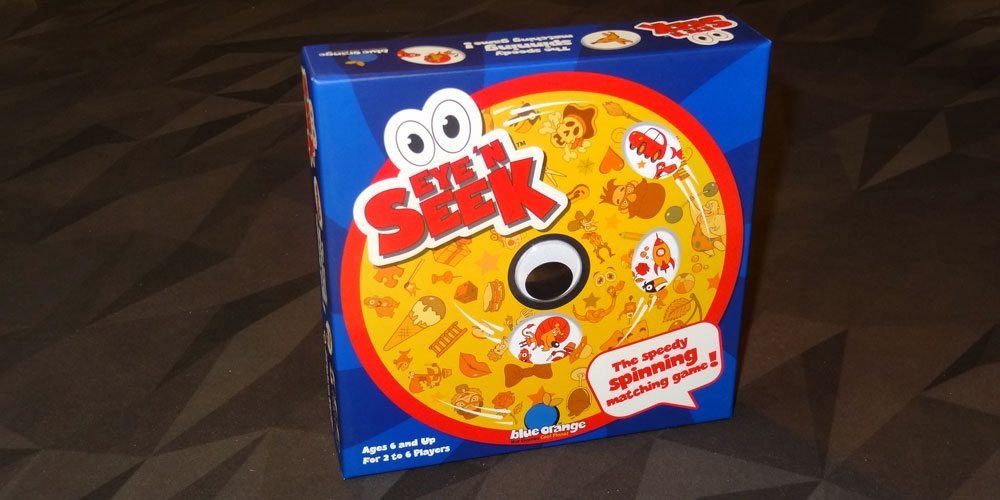

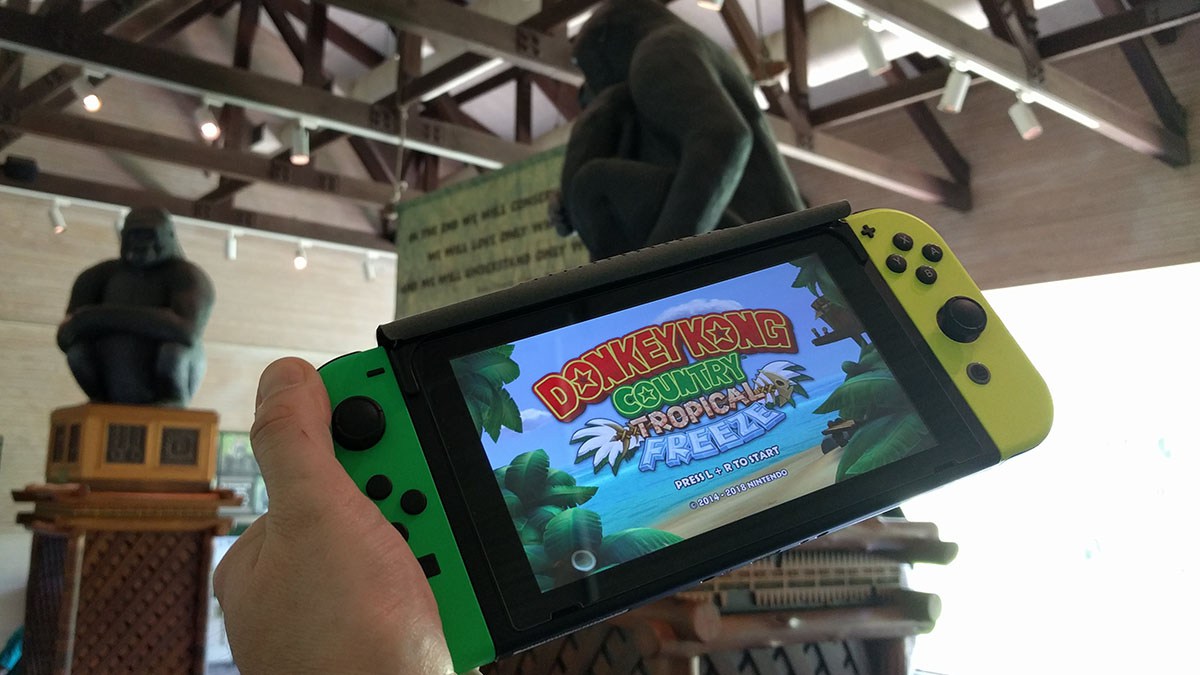
Thanks for the detailed review. I must say I can’t really afford to buy board games much, but I’m really thinking and hoping to back Monster Lands, it feels like just my kind of game.
Yeah, I hear you Adam, there so many great games, and never enough time or funds.
I would definitely consider backing this one. Great production values and more than enough complexity in the game to keep you coming back to it.